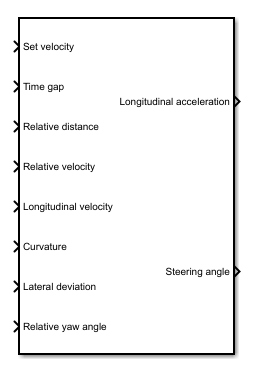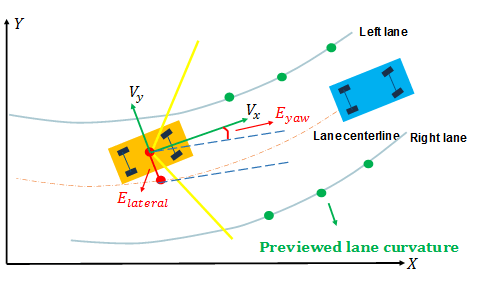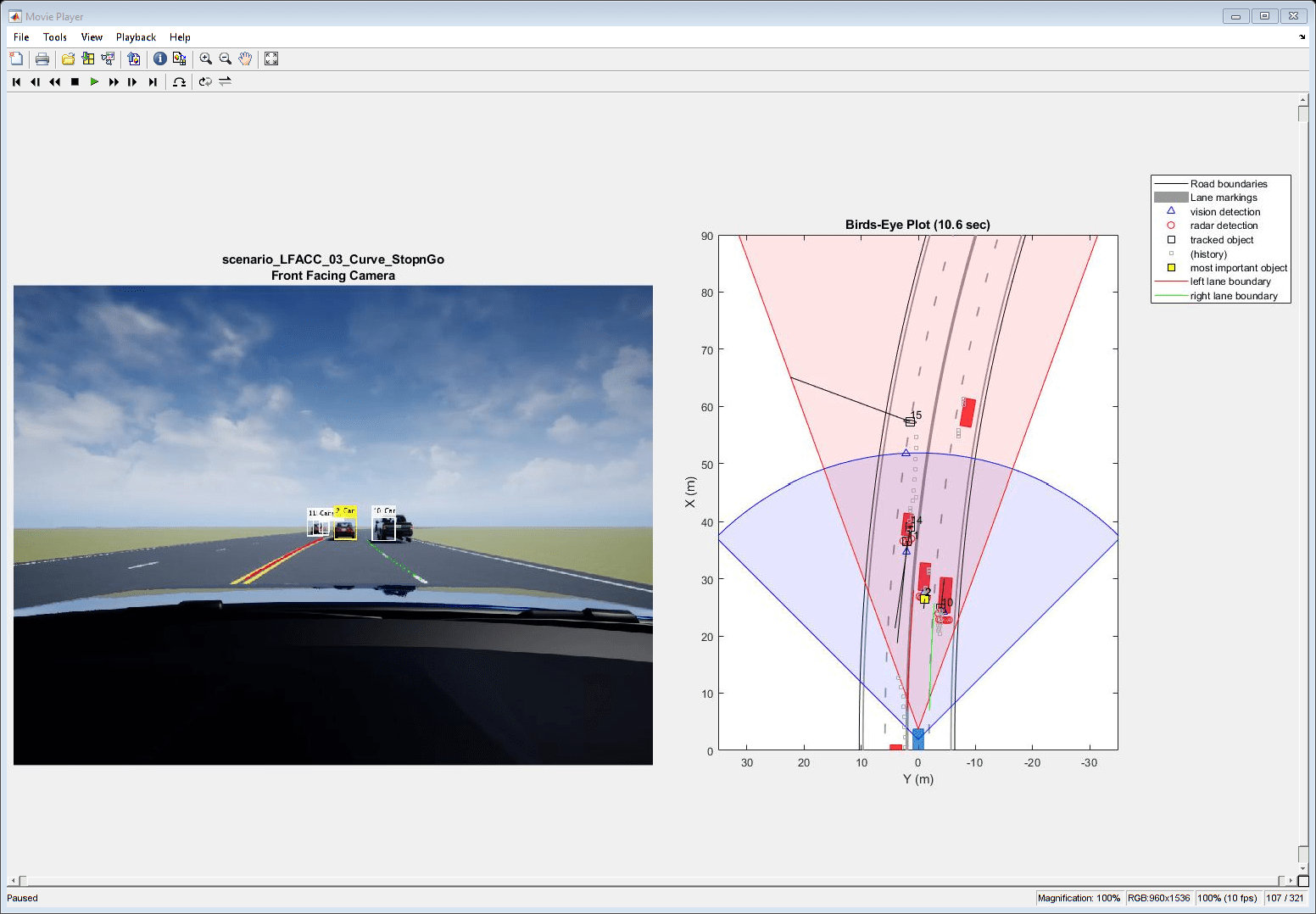Path Following Control System
Simulate path-following control using adaptive model predictive controller
Since R2019a
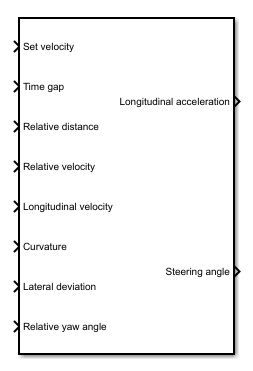
Libraries:
Model Predictive Control Toolbox /
Automated Driving
Description
The Path Following Control System block simulates a path-following control (PFC) system that keeps an ego vehicle traveling along the center of a straight or curved road while tracking a set velocity and maintaining a safe distance from a lead vehicle. To do so, the controller adjusts both the longitudinal acceleration and front steering angle of the ego vehicle. The block computes optimal control actions while satisfying safe distance, velocity, acceleration, and steering angle constraints using adaptive model predictive control (MPC).
This block combines the capabilities of the Lane Keeping Assist System and Adaptive Cruise Control System blocks into a single controller.
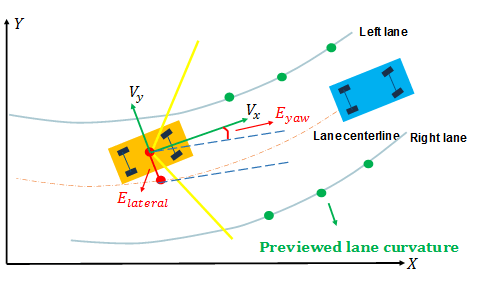
To customize your controller, for example to use advanced MPC features or modify controller initial conditions, click Create PFC subsystem.
Ports
Input
Set velocity — Ego vehicle velocity setpoint
nonnegative scalar
Ego vehicle velocity setpoint in m/s. When there is no lead vehicle, the controller tracks this velocity.
Time gap — Safe time gap
nonnegative scalar
Safe time gap in seconds between the lead vehicle and the ego vehicle. This time gap is used to calculate the minimum safe following distance constraint. For more information, see Safe Following Distance.
Relative distance — Distance between lead vehicle and ego vehicle
positive scalar
Distance in meters between lead vehicle and ego vehicle. To calculate this signal, subtract the ego vehicle position from the lead vehicle position.
Relative velocity — Velocity difference between lead vehicle and ego vehicle
scalar
Velocity difference in meters per second between lead vehicle and ego vehicle. To calculate this signal, subtract the ego vehicle velocity from the lead vehicle velocity.
Longitudinal velocity — Ego vehicle velocity
nonnegative scalar
Ego vehicle velocity in m/s.
Curvature — Road curvature
scalar | vector
Road curvature, specified as 1/R, where R is the radius of the curve in meters.
The road curvature is:
Positive when the road curves toward the positive Y axis of the global coordinate system.
Negative when the road curves toward the negative Y axis of the global coordinate system.
Zero for a straight road.
The controller models the road curvature as a measured disturbance with previewing. You can specify the curvature as a:
Scalar signal — Specify the curvature for the current control interval. The controller uses this curvature value across the prediction horizon.
Vector signal with length less than or equal to the Prediction Horizon parameter — Specify the current and predicted curvature values across the prediction horizon. If the length of the vector is less than the prediction horizon, then the controller uses the final curvature value in the vector for the remainder of the prediction horizon.
Lateral deviation — Ego vehicle lateral deviation
scalar
Ego vehicle lateral deviation in meters from the centerline of the lane. The lateral deviation e1 is positive when the ego vehicle is to the right of the centerline and negative when the ego vehicle is to the left of the centerline.
Relative yaw angle — Angle from lane centerline
scalar
Ego vehicle longitudinal axis angle in radians from the centerline of the lane, defined as:
Here, θe is the ego vehicle angle and θc is the centerline angle, with both angles defined in the global coordinate frame.
Minimum longitudinal acceleration — Minimum ego vehicle acceleration
scalar
Minimum ego vehicle longitudinal acceleration constraint in m/s2. Use this input port when the minimum acceleration varies at run time.
Dependencies
To enable this port, select corresponding Use external source parameter.
Maximum longitudinal acceleration — Maximum ego vehicle acceleration
scalar
Maximum ego vehicle longitudinal acceleration constraint in m/s2. Use this input port when the maximum acceleration varies at run time.
Dependencies
To enable this port, select corresponding Use external source parameter.
Minimum steering angle — Minimum front steering angle
scalar
Minimum front steering angle constraint in radians. Use this input port when the minimum steering angle varies at run time.
Dependencies
To enable this port, select corresponding Use external source parameter.
Maximum steering angle — Maximum front steering angle
scalar
Maximum front steering angle constraint in radians. Use this input port when the maximum steering angle varies at run time.
Dependencies
To enable this port, select corresponding Use external source parameter.
Enable optimization — Controller optimization enable signal
scalar
Controller optimization enable signal. When this signal is:
Nonzero, the controller performs optimization calculations and generates the Longitudinal acceleration and Steering angle control signals.
Zero, the controller does not perform optimization calculations. In this case, the Longitudinal acceleration and Steering angle output signals remain at the values they had when the optimization was disabled. The controller continues to update its internal state estimates.
Dependencies
To enable this port, select the Use external signal to enable or disable optimization parameter.
External control signal — Control signals applied to ego vehicle
vector of length two
Actual control signals applied to the ego vehicle. The first element of this signal is the longitudinal acceleration in m/s2, and the second element is the steering angle in radians. The controller uses these signals to estimate the ego vehicle model states. Use this input port when the control signals applied to the ego vehicle do not match the optimal control signals computed by the model predictive controller. This mismatch can occur when, for example:
The Path Following Control System is not the active controller. Maintaining an accurate state estimate when the controller is not active prevents bumps in the control signals when the controller becomes active.
The steering or acceleration actuator fails and does not provide the correct control signal to the ego vehicle.
Dependencies
To enable this port, select the Use external control signal for bumpless transfer between PFC and other controllers parameter.
Vehicle dynamics matrix A — State matrix of ego vehicle predictive model
square matrix
State matrix of ego vehicle predictive model. The number of rows in the state matrix corresponds to the number of states in the predictive model. This matrix must be square.
The ego vehicle predictive model defined by Vehicle dynamics matrix A, Vehicle dynamics matrix B, and Vehicle dynamics matrix C must be minimal.
Dependencies
To enable this port, select the Use vehicle model parameter.
Vehicle dynamics matrix B — Input-to-state matrix of ego vehicle predictive model
matrix with two columns
Input-to-state matrix of ego vehicle predictive model. The number of rows in this signal must match the number of rows in Vehicle dynamics matrix A.
The ego vehicle predictive model defined by Vehicle dynamics matrix A, Vehicle dynamics matrix B, and Vehicle dynamics matrix C must be minimal.
Dependencies
To enable this port, select the Use vehicle model parameter.
Vehicle dynamics matrix C — State-to-output matrix of ego vehicle predictive model
matrix with three rows
State-to-output matrix of ego vehicle predictive model. The number of columns in this signal must match the number of rows in Vehicle dynamics matrix A.
The ego vehicle predictive model defined by Vehicle dynamics matrix A, Vehicle dynamics matrix B, and Vehicle dynamics matrix C must be minimal.
Dependencies
To enable this port, select the Use vehicle model parameter.
Output
Longitudinal acceleration — Acceleration control signal
scalar
Acceleration control signal in m/s2 generated by the controller.
Steering angle — Front steering angle control signal
scalar
Front steering angle control signal in radians generated by the controller. The front steering angle is the angle of the front tires from the longitudinal axis of the vehicle. The steering angle is positive towards the positive lateral axis of the ego vehicle.
Parameters
Parameters Tab
Ego VehicleUse vehicle parameters — Define ego vehicle model using vehicle properties
on (default) | off
Select this parameter to define the ego vehicle model used by the MPC controller by specifying properties of the ego vehicle. The ego vehicle model is the linear model from the longitudinal acceleration and front steering angle to the longitudinal velocity, lateral velocity, and yaw angle rate.
To define the vehicle model, specify the following block parameters:
Total mass
Yaw moment of inertia
Longitudinal distance from center of gravity to front tires
Longitudinal distance from center of gravity to rear tires
Cornering stiffness of front tires
Cornering stiffness of rear tires
Longitudinal acceleration tracking time constant
For more information on the ego vehicle model, see Ego Vehicle Predictive Model
Selecting this parameter clears the Use vehicle model parameter.
Programmatic Use
Block Parameter:
ModelType |
| Type: string, character vector |
Default:
"Use vehicle parameters" |
Use vehicle model — Define ego vehicle model using state-space matrices
off (default) | on
Select this parameter to define the state-space matrices of the ego vehicle model used by the MPC controller. The ego vehicle model is the linear model from the longitudinal acceleration and front steering angle to the longitudinal velocity, lateral velocity, and yaw angle rate.
To define the initial internal model, specify the A, B, and C state-space matrices. The internal model must be a minimal realization with no direct feedthrough, and the dimensions of A, B, and C must be consistent.
Typically, the ego vehicle model is velocity-dependent, and therefore, it varies over time. To update the internal model at run time, use the Vehicle dynamics A, Vehicle dynamics B, and Vehicle dynamics C input ports.
For more information on the ego vehicle model, see Ego Vehicle Predictive Model
Selecting this parameter clears the Use vehicle parameters parameter.
Programmatic Use
Block Parameter:
ModelType |
| Type: string, character vector |
Default:
"Use vehicle parameters" |
Total mass — Ego vehicle mass
1575 (default) | positive scalar
Ego vehicle mass in kg.
Dependencies
To enable this parameter, select the Use vehicle parameters parameter.
Programmatic Use
Block Parameter:
VehicleMass |
| Type: string, character vector |
Default:
"1575" |
Yaw moment of inertia — Moment of inertia about the ego vehicle vertical axis
2875 (default) | positive scalar
Moment of inertia about the ego vehicle vertical axis in Kg·m2.
Dependencies
To enable this parameter, select the Use vehicle parameters parameter.
Programmatic Use
Block
Parameter:
VehicleYawInertia |
| Type: string, character vector |
Default:
"2875" |
Longitudinal distance from center of gravity to front tires — Distance from the ego vehicle center of mass to its front tires
1.2 (default) | positive scalar
Distance from the ego vehicle center of mass to its front tires in meters, measured along the longitudinal axis of the vehicle.
Dependencies
To enable this parameter, select the Use vehicle parameters parameter.
Programmatic Use
Block Parameter:
LengthToFront |
| Type: string, character vector |
Default:
"1.2" |
Longitudinal distance from center of gravity to rear tires — Distance from the ego vehicle center of mass to its rear tires
1.6 (default) | positive scalar
Distance from the ego vehicle center of mass to its rear tires in meters, measured along the longitudinal axis of the vehicle.
Dependencies
To enable this parameter, select the Use vehicle parameters parameter.
Programmatic Use
Block Parameter:
LengthToRear |
| Type: string, character vector |
Default:
"1.6" |
Cornering stiffness of front tires — Front tire stiffness
19000 (default) | positive scalar
Front tire stiffness in N/rad, defined as the relationship between the side force on the front tires and the angle of the tires to the longitudinal axis of the vehicle.
Dependencies
To enable this parameter, select the Use vehicle parameters parameter.
Programmatic Use
Block Parameter:
FrontTireStiffness |
| Type: string, character vector |
Default:
"19000" |
Cornering stiffness of rear tires — Rear tire stiffness
33000 (default) | positive scalar
Rear tire stiffness in N/rad, defined as the relationship between the side force on the rear tires and the angle of the tires to the longitudinal axis of the vehicle.
Dependencies
To enable this parameter, select the Use vehicle parameters parameter.
Programmatic Use
Block Parameter:
RearTireStiffness |
| Type: string, character vector |
Default:
"33000" |
Longitudinal acceleration tracking time constant — Time constant for acceleration tracking
0.5 (default) | positive scalar
Time constant for tracking longitudinal acceleration, specified in seconds.
Dependencies
To enable this parameter, select the Use vehicle parameters parameter.
Programmatic Use
Block Parameter:
AccelTimeConstant |
| Type: string, character vector |
Default:
"0.5" |
A — Initial state matrix of ego vehicle predictive model
square matrix
Initial state matrix of ego vehicle predictive model. The number of rows in the state matrix corresponds to the number of states in the predictive model. This matrix must be square.
The initial ego vehicle predictive model defined by A, B, and C must be minimal.
Typically, the ego vehicle model varies over time. To update the state matrix at run time, use the Vehicle dynamics A input port.
Dependencies
To enable this parameter, select the Use vehicle model parameter.
Programmatic Use
Block Parameter:
EgoModelMatrixA |
| Type: string, character vector |
Default:
"[-4.4021
,-12.4603;1.3913,-5.1868]" |
B — Initial input-to-state matrix of ego vehicle predictive model
matrix with two columns
Initial input-to-state matrix of ego vehicle predictive model. The number of rows in this parameter must match the number of rows in A.
The initial ego vehicle predictive model defined by A, B, and C must be minimal.
Typically, the ego vehicle model varies over time. To update the input-to-state matrix at run time, use the Vehicle dynamics B input port.
Dependencies
To enable this parameter, select the Use vehicle model parameter.
Programmatic Use
Block Parameter:
EgoModelMatrixB |
| Type: string, character vector |
Default:
"[24.1270;15.8609]" |
C — Initial state-to-output matrix of ego vehicle predictive model
matrix with three rows
Initial state-to-output matrix of ego vehicle predictive model. The number of columns in this parameter must match the number of rows in A.
The initial ego vehicle predictive model defined by A, B, and C must be minimal.
Typically, the ego vehicle model varies over time. To update the state-to-output matrix at run time, use the Vehicle dynamics C input port.
Dependencies
To enable this parameter, select the Use vehicle model parameter.
Programmatic Use
Block Parameter:
EgoModelMatrixC |
| Type: string, character vector |
Default:
"[1,0;0,1]" |
Initial longitudinal velocity — Initial velocity of the ego vehicle model
15 (default) | nonnegative scalar
Initial velocity of the ego vehicle model in m/s, which can differ from the actual ego vehicle initial velocity.
This value is used to configure the initial conditions of the model predictive controller. For more information, see Initial Conditions.
Note
A very small initial velocity, for example eps, can produce a
nonminimal realization for the controller plant model, causing an error. To prevent
this error, set the initial velocity to a larger value, for example
1e-3.
Programmatic Use
Block Parameter:
InitialLongVel |
| Type: string, character vector |
Default:
"15" |
Transport lag between model inputs and outputs — Total transport lag in ego vehicle model
0 (default) | nonnegative scalar
Total transport lag, τ, in the ego vehicle model in seconds. This lag includes actuator, sensor, and communication lags. For each input-output channel, the transport lag model is:
Programmatic Use
Block Parameter:
TransportLag |
| Type: string, character vector |
Default:
"0" |
Maintain safe distance between lead vehicle and ego vehicle — Enable spacing control
on (default) | off
To configure the safe following distance, set the Default spacing parameter. For more information on the safe following distance used by the controller, see Safe Following Distance.
Programmatic Use
Block Parameter:
spaceCtrl |
| Type: string, character vector |
Default:
"on" |
Default spacing — Minimum spacing to lead vehicle
10 (default) | nonnegative scalar
Minimum spacing in meters between the lead vehicle and the ego vehicle. This value corresponds to the target relative distance between the ego and lead vehicles when the ego vehicle velocity is zero.
This value is used to calculate the:
Minimum safe following distance. For more information, see Safe Following Distance.
Controller initial conditions. For more information, see Initial Conditions.
Dependencies
To enable this parameter, select the Maintain safe distance between lead vehicle and ego vehicle parameter.
Programmatic Use
Block Parameter:
DefaultSpacing |
| Type: string, character vector |
Default:
"10" |
Controller Tab
Path Following Controller ConstraintsMinimum steering angle — Minimum front steering angle
-0.26 (default) | scalar between -pi/2 and pi/2
Minimum front steering angle constraint in radians.
If the minimum steering angle varies over time, add the Minimum steering angle input port to the block by selecting Use external source.
Dependencies
This parameter must be less than the Maximum steering angle parameter.
Programmatic Use
Block
Parameter:
MinSteering |
| Type: string, character vector |
Default:
"-0.26" |
Maximum steering angle — Maximum front steering angle
0.26 (default) | scalar between -pi/2 and pi/2
Maximum front steering angle constraint in radians.
If the maximum steering angle varies over time, add the Maximum steering angle input port to the block by selecting Use external source.
Dependencies
This parameter must be greater than the Minimum steering angle parameter.
Programmatic Use
Block
Parameter:
MaxSteering |
| Type: string, character vector |
Default:
"0.26" |
Minimum longitudinal acceleration — Minimum ego vehicle acceleration
-3 (default) | scalar
Minimum ego vehicle longitudinal acceleration constraint in m/s2.
If the minimum acceleration varies over time, add the Minimum longitudinal acceleration input port to the block by selecting Use external source.
Programmatic Use
Block Parameter:
MinAcceleration |
| Type: string, character vector |
Default:
"-3" |
Maximum longitudinal acceleration — Maximum ego vehicle acceleration
2 (default) | scalar
Maximum ego vehicle longitudinal acceleration constraint in m/s2.
If the maximum acceleration varies over time, add the Maximum longitudinal acceleration input port to the block by selecting Use external source.
Programmatic Use
Block Parameter:
MaxAcceleration |
| Type: string, character vector |
Default:
"2" |
Sample time — Controller sample time
0.1 (default) | positive scalar
Controller sample time in seconds.
Programmatic Use
Block Parameter:
Ts |
| Type: string, character vector |
Default:
"0.1" |
Prediction horizon — Controller prediction horizon
10 (default) | positive integer
Controller prediction horizon steps. The controller prediction time is the product of the sample time and the prediction horizon.
Programmatic Use
Block Parameter:
PredictionHorizon |
| Type: string, character vector |
Default:
"30" |
Control horizon — Controller control horizon
3 (default) | positive integer | vector of positive integers
Controller control horizon, specified as one of the following:
Positive integer less than or equal to the Prediction horizon parameter. In this case, the controller computes m free control moves occurring at times k through k+m-1, and holds the controller output constant for the remaining prediction horizon steps from k+m through k+p-1. Here, k is the current control interval.
Vector of positive integers, [m1, m2, …], where the sum of the integers equals the Prediction horizon parameter. In this case, the controller computes M blocks of free moves, where M is the length of the control horizon vector. The first free move applies to times k through k+m1-1, the second free move applies from time k+m1 through k+m1+m2-1, and so on. Using block moves can improve the robustness of your controller.
Programmatic Use
Block Parameter:
ControlHorizon |
| Type: string, character vector |
Default:
"3" |
Weight on velocity tracking — Tuning weight for longitudinal velocity tracking
0.1 (default) | positive scalar
Tuning weight for longitudinal velocity tracking. To produce smaller velocity-tracking errors, increase this weight.
Programmatic Use
Block Parameter:
LongWeight |
| Type: string, character vector |
Default:
"0.1" |
Weight on lateral error — Tuning weight for lateral error
1 (default) | positive scalar
Tuning weight for lateral error. To produce smaller lateral errors, increase this weight.
Programmatic Use
Block Parameter:
LateralWeight |
| Type: string, character vector |
Default:
"1" |
Weight on change of longitudinal acceleration — Tuning weight for change in longitudinal acceleration
0.1 (default) | positive scalar
Tuning weight for changes in longitudinal acceleration. To produce less-aggressive vehicle acceleration, increase this weight.
Programmatic Use
Block Parameter:
AccelRateWeight |
| Type: string, character vector |
Default:
"0.1" |
Weight on change of steering angle — Tuning weight for change in steering angle
0.1 (default) | positive scalar
Tuning weight for changes in steering angle. To produce less-aggressive steering angle changes, increase this weight.
Programmatic Use
Block Parameter:
SteerRateWeight |
| Type: string, character vector |
Default:
"0.1" |
Block Tab
Use suboptimal solution — Apply suboptimal solution after specified number of iterations
off (default) | on
Configure the controller to apply a suboptimal solution after a specified maximum number of iterations, which guarantees the worst-case execution time for your controller.
For more information, see Suboptimal QP Solution.
Dependencies
After selecting this parameter, specify the Maximum iteration number parameter.
Programmatic Use
Block Parameter:
suboptimal |
| Type: string, character vector |
Default:
"off" |
Maximum iteration number — Maximum optimization iterations
10 (default) | positive integer
Maximum number of controller optimization iterations.
Dependencies
To enable this parameter, select the Use suboptimal solution parameter.
Programmatic Use
Block
Parameter:
maxiter |
| Type: string, character vector |
Default:
"10" |
Use external signal to enable or disable optimization — Add port for enabling optimization
off (default) | on
To add the Enable optimization input port to the block, select this parameter.
Programmatic Use
Block
Parameter:
optmode |
| Type: string, character vector |
Default:
"off" |
Use external signal for bumpless transfer between PFC and other controllers — Add external control signal input port
off (default) | on
To add the External control signal input port to the block, select this parameter.
Programmatic Use
Block Parameter:
trackmode |
| Type: string, character vector |
Default:
"off" |
Create PFC subsystem — Create custom controller
button
Generate a custom PFC subsystem, which you can modify for your application. The configuration data for the custom controller is exported to the MATLAB® workspace as a structure.
You can modify the custom controller subsystem to:
Modify default MPC settings or use advanced MPC features.
Modify the default controller initial conditions.
Use different application settings, such as a custom safe following distance definition.
Algorithms
Ego Vehicle Predictive Model
The default ego vehicle predictive model for path-following control is the combination of two state-space models, one for adaptive cruise control and one for lane keeping.
The predictive state-space model for adaptive cruise control is:
Here, τ is the Longitudinal acceleration tracking time constant parameter.
The input to this model is the longitudinal acceleration in m/s2, and the output is the longitudinal velocity in meters per second.
The predictive state-space model for lane keeping is:
Here:
VX is the longitudinal velocity of the car. At the start of the simulation, this velocity is equal to the Initial condition for longitudinal velocity parameter. At run time, this velocity is equal to the Longitudinal velocity input signal.
m is the Total mass parameter.
IZ is the Yaw moment of inertia parameter.
LF is the Longitudinal distance from center of gravity to front tires parameter.
LR is the Longitudinal distance from center of gravity to rear tires parameter.
CF is the Cornering stiffness of front tires parameter.
CR is the Cornering stiffness of rear tires parameter.
The input to this model is the steering angle in radians. The outputs are the lateral velocity in meters per second and yaw angle rate in radians per second.
The Path Following Control System block combines these models as follows:
The inputs to this combined model are the longitudinal acceleration in m/s2 and steering angle in radians. The outputs are the longitudinal velocity in meters per second, lateral velocity in meters per second, and yaw angle rate in radians per second.
The controller creates its internal predictive model by augmenting the ego vehicle dynamic model. The augmented model includes the road curvature as a measured disturbance input signal.
To define a different ego vehicle predictive model, select the Use vehicle model parameter, and specify the initial state-space model. Then, specify the run-time values of the state-space matrices using the Vehicle dynamics A, Vehicle dynamics B, and Vehicle dynamics C input signals.
Safe Following Distance
When the Maintain safe distance between lead vehicle and ego vehicle parameter is selected, the model predictive controller computes the safe following distance constraint; that is, the minimum relative distance between the lead and ego vehicle, as:
Here:
DS is the Default spacing parameter.
GT is the Time gap input signal.
VE is the Longitudinal velocity input signal.
To define a different safe following distance constraint, create a custom path-following control system by, on the Block tab, clicking Create PFC subsystem.
Initial Conditions
By default, the model predictive controller assumes the following initial conditions for the ego vehicle:
Longitudinal velocity is equal to the Initial longitudinal velocity parameter.
Longitudinal acceleration is zero.
Lateral velocity is zero.
Steering angle is zero.
Yaw angle rate is zero.
When the Maintain safe distance between lead vehicle and ego vehicle parameter is selected, the controller assumes the following additional initial conditions:
The lead vehicle longitudinal velocity is equal to the Initial longitudinal velocity parameter.
Relative distance between the lead vehicle and ego vehicle is:
Here:
DS is the Default spacing parameter.
GT is the time gap and is assumed to be
1.4.VE is the Initial longitudinal velocity parameter.
If the initial conditions in your model do not match these conditions, the Steering angle and Longitudinal acceleration outputs can exhibit initial bumps at the start of the simulation.
To modify the controller initial conditions to match your simulation, create a custom path-following control system by, on the Block tab, clicking Create PFC subsystem.
Extended Capabilities
C/C++ Code Generation
Generate C and C++ code using Simulink® Coder™.
PLC Code Generation
Generate Structured Text code using Simulink® PLC Coder™.
Version History
Introduced in R2019a
MATLAB Command
You clicked a link that corresponds to this MATLAB command:
Run the command by entering it in the MATLAB Command Window. Web browsers do not support MATLAB commands.

Select a Web Site
Choose a web site to get translated content where available and see local events and offers. Based on your location, we recommend that you select: .
You can also select a web site from the following list:
How to Get Best Site Performance
Select the China site (in Chinese or English) for best site performance. Other bat365 country sites are not optimized for visits from your location.
Americas
- América Latina (Español)
- Canada (English)
- United States (English)
Europe
- Belgium (English)
- Denmark (English)
- Deutschland (Deutsch)
- España (Español)
- Finland (English)
- France (Français)
- Ireland (English)
- Italia (Italiano)
- Luxembourg (English)
- Netherlands (English)
- Norway (English)
- Österreich (Deutsch)
- Portugal (English)
- Sweden (English)
- Switzerland
- United Kingdom (English)
